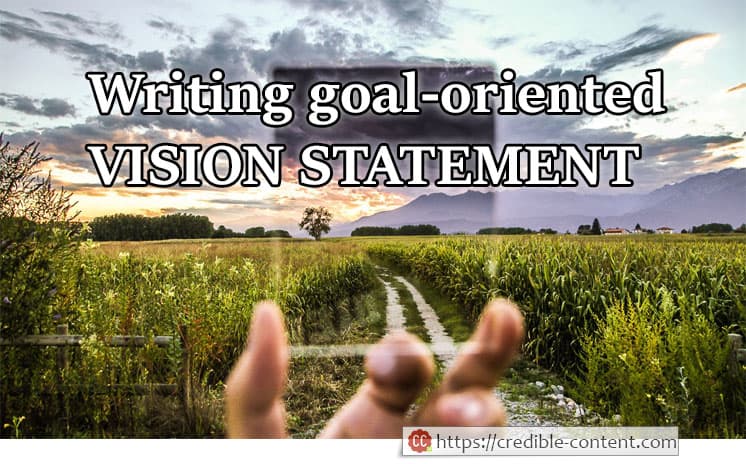Every corporate website has a vision statement. I encourage even smaller businesses to have a vision statement because it gives an idea to prospective customers and clients what the business stands for, what are its values and how it plans to chart its growth path. I know, lots of corporate stuff, but what I want to say is a vision statement is not only reassuring to your customers and clients, it also helps you stay focused. Again, what a mean to say is writing a good vision statement is serious stuff. So even if it takes a couple of weeks, it’s worth it.
Though, as a content writer, before you start worrying, I don’t take that much time to come up with a good vision statement provided I have all the base material needed for it from you.
What is a vision statement?
The explanation depends on what you understand by “vision”. A generic explanation is, an ability to decide your future actions based on your current and predicted capabilities. So when you say, “this person has a vision” it means the person knows what he or she is going to do vis-a-vis himself or herself and people associated with him or her in the next 5 years, 10 years or 20 years.
As a business, your vision statement tells your customers and clients why you will still be existing in the coming months and years and what will you be achieving by then. It takes into account where you are currently, how you recognise and perceive your capabilities and how your inherent qualities as well as the resources at your disposal are going to help you achieve what you intend to achieve in the coming months and years. When you lucidly write this down and publish it somewhere, it becomes your vision statement.
What is a goal-oriented vision statement in terms of content writing?
In terms of content writing every page that you create, every blog post that you publish, needs to have a goal. Okay, it doesn’t always happen that way, but this is the underlying philosophy, that every action of yours must carry an intended goal. For instance, why am I writing this blog post? What do I want you to do after reading this blog post? I’m not going to talk about it right now, but I must have something in mind otherwise why am I sitting here spending my time?
Just as any piece of content on your website, the web page that contains your vision statement, hence, must also have a goal.
Your business website is often accessed by your customers and clients (former, current and prospective) as well as your employees. A goal-oriented vision statement gives an idea to your prospective customers and clients of your present state as well as your future plans. If I come across your vision statement I can know how you feel about your business, how you plan to grow it and sustain it and how you place yourself vis-à-vis the challenges and opportunities that you currently face or have. I will either feel confident or indifferent after reading your vision statement. I should feel confident.
Before doing business with you I must know you have a direction and purpose and it makes sense to stick with you for a long time. You’re not here just for a few weeks or a few months. Even after a few years you’re still going to be around. Every customer and client needs that assurance. This assurance must be the goal of your vision statement.
The vision statement on your website also gives a sense of purpose and direction to your employees. They know what you want your organisation to achieve. They know that you understand your current problems and challenges and you also recognise the current opportunities and advantages.
How to write a goal-oriented vision statement
- Keep it short: Don’t try to write a blog post or an essay on your vision statement. Keep it around 2-3 sentences or at the most a couple of paragraphs.
- Write down the goal first, somewhere: It’s very important to know what is the goal of your vision statement. Whom do you want to communicate to? Your customers and clients? Your employees? Your stakeholders like business partners, investors, shareholders or suppliers?
- What is your ultimate reason for existence: Why your business exists? What do you intend to achieve? Whom do you want to serve? Why?
- How do you plan to expand your business: Growth is a natural evolutionary trait. You begin to stagnate if you don’t grow. Consciously or unconsciously everybody acknowledges that and knows that. Having a growth plan means you’re going to take all necessary steps to make sure you get more customers and clients and your service improves. This is reassuring to your prospective customers and clients.
- Based on what values you plan to expand your business: Values are like the moral parameters your organisation works within. It tells people you’re not going to compromise on fundamental values. You are not going to cheat the stakeholders and people who deal with you while trying to grow.
Vision statements normally have the same sort of language for every business and you can easily copy/paste text from other websites but this is not recommended. Your vision statement should be unique to your business and people can see through if you’re simply copying others.

